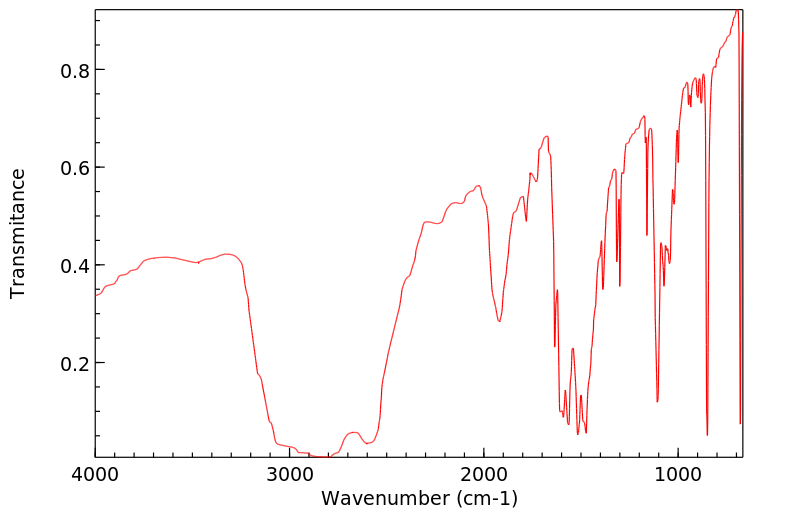3,5-二甲基苯胺盐酸盐 | 85518-76-9
中文名称
3,5-二甲基苯胺盐酸盐
中文别名
——
英文名称
3,5-dimethylaniline hydrochloride
英文别名
Benzenamine, 3,5-dimethyl-, hydrochloride;3,5-dimethylaniline;hydrochloride
CAS
85518-76-9
化学式
C8H12N*Cl
mdl
——
分子量
157.643
InChiKey
RQBHTTDLFFGKJR-UHFFFAOYSA-N
BEILSTEIN
——
EINECS
——
-
物化性质
-
计算性质
-
ADMET
-
安全信息
-
SDS
-
制备方法与用途
-
上下游信息
-
文献信息
-
表征谱图
-
同类化合物
-
相关功能分类
-
相关结构分类
计算性质
-
辛醇/水分配系数(LogP):2.31
-
重原子数:10
-
可旋转键数:0
-
环数:1.0
-
sp3杂化的碳原子比例:0.25
-
拓扑面积:26
-
氢给体数:2
-
氢受体数:1
反应信息
-
作为反应物:描述:3,5-二甲基苯胺盐酸盐 在 四磷十氧化物 、 N,N-二甲基环己胺 作用下, 以 乙醇 为溶剂, 反应 44.0h, 生成 N-(3,5-dimethylphenyl)-1-(piperidin-1-ylmethyl)-5,6,7,8-tetrahydropyrazolo[3,4-b]quinolin-4-amine参考文献:名称:Nielsen, Soren V.; Pedersen, Erik B., Liebigs Annalen der Chemie, 1986, # 10, p. 1728 - 1735摘要:DOI:
-
作为产物:描述:参考文献:名称:邻位三羰基化合物可逆地捕获和释放芳香胺摘要:在本文中,我们报道了二苯丙烷三酮(DPPT)可逆地捕获和释放芳香胺。在环境温度下,很容易将芳香胺加到中心羰基上,以提供具有半缩醛结构的DPPT芳香胺加合物(DPPT-芳香胺)。另一方面,用稀盐酸(HCl)洗涤DPPT-芳族胺溶液可以成功回收DPPT,从而证明该系统具有可逆性。DOI:10.1016/j.tet.2016.03.093
文献信息
-
[EN] PHENYL-GUANIDINE DERIVATIVES<br/>[FR] DÉRIVÉS PHÉNYL-GUANIDINES申请人:UNIV NAC QUILMES公开号:WO2013053726A1公开(公告)日:2013-04-18Provided herein are phenyl-guanidine derivatives for the inhibition of Rac1 which blocks its interaction with guanosine exchange factors (GEFs) belonging to the DBL family as agents for the treatment of aggressive and/or resistant tumours, as well as pharmaceutical compositions comprising them, their use in therapy and processes for their preparation.
-
Phosphorus pentoxide in organic synthesis. XX. Synthesis of<i>N</i>-aryl-7<i>H</i>-pyrrolo[2,3-d]pyrimidin-4-amines作者:Anker Jørgensen、Khairy A. M. El-Bayouki、Erik B. PedersenDOI:10.1002/jhet.5570220351日期:1985.5N-Aryl-7H-pyrrolo[2,3-d]pyrimidine-4-amines 7 were prepared in 30-67% yields by treating N7-(1-phenyl-ethyl)pyrrolo[2,3-d]pyrimidin-4(3H)-ones 2 with a mixture of phosphorus pentoxide, triethylamine hydrochloride, and an appropriate arylamine hydrochloride at 240° for 3-7 hours.
-
Mild N-deacylation of secondary amides by alkylation with organocerium reagents作者:Ai-E Wang、Zong Chang、Yong-Peng Liu、Pei-Qiang HuangDOI:10.1016/j.cclet.2015.05.033日期:2015.9Secondary amides are a class of highly stable compounds serving as versatile starting materials, intermediates and directing groups (amido groups) in organic synthesis. The direct deacylation of secondary amides to release amines is an important transformation in organic synthesis. Here, we report a protocol for the deacylation of secondary amides and isolation of amines. The method is based on the activation
-
High-throughput approach for the identification of anilinium-based ionic liquids that are suitable for electropolymerisation作者:Muhammad E. Abdelhamid、Timothy Murdoch、Tamar L. Greaves、Anthony P. O'Mullane、Graeme A. SnookDOI:10.1039/c5cp02294k日期:——
We report the synthesis of new protic ionic liquids (PILs) based on aniline derivatives and the use of high-throughput (HT) techniques to screen possible candidates.
-
Multicomponent One-pot Synthesis of Substituted 4H-pyrimido [2,1-b] [1,3] Benzothiazole Curcumin Derivatives and Their Antimicrobial Evaluation作者:Shikha Agarwal、Dinesh Agarwal、Divyani Gandhi、Kshamta Goyal、Pradeep GoyalDOI:10.2174/1570178615666180326161710日期:2018.8.8A novel series of ten substituted 4H-pyrimido [2,1-b] [1,3] benzothiazole curcumin derivatives have been synthesized and evaluated for their antimicrobial activity against Gram positive and Gram negative bacteria viz. Pseudomonas aeruginosa, Staphylococcus aureus, Bacillus cereus and against fungi viz. Alternaria solani, Aspergillus niger, Fusarium culmorum and Rhizopus stolonifer. The mechanism involves condensation of substituted benzaldehyde and curcumin via Knovenegal reaction which further reacts with substituted benzothiazole through Michael addition in the presence of pyridine catalyst using methanol as a solvent. The synthesized compounds were analyzed by elemental and spectral analysis.
表征谱图
-
氢谱1HNMR
-
质谱MS
-
碳谱13CNMR
-
红外IR
-
拉曼Raman
-
峰位数据
-
峰位匹配
-
表征信息
同类化合物
(βS)-β-氨基-4-(4-羟基苯氧基)-3,5-二碘苯甲丙醇
(S,S)-邻甲苯基-DIPAMP
(S)-(-)-7'-〔4(S)-(苄基)恶唑-2-基]-7-二(3,5-二-叔丁基苯基)膦基-2,2',3,3'-四氢-1,1-螺二氢茚
(S)-盐酸沙丁胺醇
(S)-3-(叔丁基)-4-(2,6-二甲氧基苯基)-2,3-二氢苯并[d][1,3]氧磷杂环戊二烯
(S)-2,2'-双[双(3,5-三氟甲基苯基)膦基]-4,4',6,6'-四甲氧基联苯
(S)-1-[3,5-双(三氟甲基)苯基]-3-[1-(二甲基氨基)-3-甲基丁烷-2-基]硫脲
(R)富马酸托特罗定
(R)-(-)-盐酸尼古地平
(R)-(-)-4,12-双(二苯基膦基)[2.2]对环芳烷(1,5环辛二烯)铑(I)四氟硼酸盐
(R)-(+)-7-双(3,5-二叔丁基苯基)膦基7''-[((6-甲基吡啶-2-基甲基)氨基]-2,2'',3,3''-四氢-1,1''-螺双茚满
(R)-(+)-7-双(3,5-二叔丁基苯基)膦基7''-[(4-叔丁基吡啶-2-基甲基)氨基]-2,2'',3,3''-四氢-1,1''-螺双茚满
(R)-(+)-7-双(3,5-二叔丁基苯基)膦基7''-[(3-甲基吡啶-2-基甲基)氨基]-2,2'',3,3''-四氢-1,1''-螺双茚满
(R)-(+)-4,7-双(3,5-二-叔丁基苯基)膦基-7“-[(吡啶-2-基甲基)氨基]-2,2”,3,3'-四氢1,1'-螺二茚满
(R)-3-(叔丁基)-4-(2,6-二苯氧基苯基)-2,3-二氢苯并[d][1,3]氧杂磷杂环戊烯
(R)-2-[((二苯基膦基)甲基]吡咯烷
(R)-1-[3,5-双(三氟甲基)苯基]-3-[1-(二甲基氨基)-3-甲基丁烷-2-基]硫脲
(N-(4-甲氧基苯基)-N-甲基-3-(1-哌啶基)丙-2-烯酰胺)
(5-溴-2-羟基苯基)-4-氯苯甲酮
(5-溴-2-氯苯基)(4-羟基苯基)甲酮
(5-氧代-3-苯基-2,5-二氢-1,2,3,4-oxatriazol-3-鎓)
(4S,5R)-4-甲基-5-苯基-1,2,3-氧代噻唑烷-2,2-二氧化物-3-羧酸叔丁酯
(4S,4''S)-2,2''-亚环戊基双[4,5-二氢-4-(苯甲基)恶唑]
(4-溴苯基)-[2-氟-4-[6-[甲基(丙-2-烯基)氨基]己氧基]苯基]甲酮
(4-丁氧基苯甲基)三苯基溴化磷
(3aR,8aR)-(-)-4,4,8,8-四(3,5-二甲基苯基)四氢-2,2-二甲基-6-苯基-1,3-二氧戊环[4,5-e]二恶唑磷
(3aR,6aS)-5-氧代六氢环戊基[c]吡咯-2(1H)-羧酸酯
(2Z)-3-[[(4-氯苯基)氨基]-2-氰基丙烯酸乙酯
(2S,3S,5S)-5-(叔丁氧基甲酰氨基)-2-(N-5-噻唑基-甲氧羰基)氨基-1,6-二苯基-3-羟基己烷
(2S,2''S,3S,3''S)-3,3''-二叔丁基-4,4''-双(2,6-二甲氧基苯基)-2,2'',3,3''-四氢-2,2''-联苯并[d][1,3]氧杂磷杂戊环
(2S)-(-)-2-{[[[[3,5-双(氟代甲基)苯基]氨基]硫代甲基]氨基}-N-(二苯基甲基)-N,3,3-三甲基丁酰胺
(2S)-2-[[[[[((1S,2S)-2-氨基环己基]氨基]硫代甲基]氨基]-N-(二苯甲基)-N,3,3-三甲基丁酰胺
(2S)-2-[[[[[[((1R,2R)-2-氨基环己基]氨基]硫代甲基]氨基]-N-(二苯甲基)-N,3,3-三甲基丁酰胺
(2-硝基苯基)磷酸三酰胺
(2,6-二氯苯基)乙酰氯
(2,3-二甲氧基-5-甲基苯基)硼酸
(1S,2S,3S,5S)-5-叠氮基-3-(苯基甲氧基)-2-[(苯基甲氧基)甲基]环戊醇
(1S,2S,3R,5R)-2-(苄氧基)甲基-6-氧杂双环[3.1.0]己-3-醇
(1-(4-氟苯基)环丙基)甲胺盐酸盐
(1-(3-溴苯基)环丁基)甲胺盐酸盐
(1-(2-氯苯基)环丁基)甲胺盐酸盐
(1-(2-氟苯基)环丙基)甲胺盐酸盐
(1-(2,6-二氟苯基)环丙基)甲胺盐酸盐
(-)-去甲基西布曲明
龙蒿油
龙胆酸钠
龙胆酸叔丁酯
龙胆酸
龙胆紫-d6
龙胆紫







